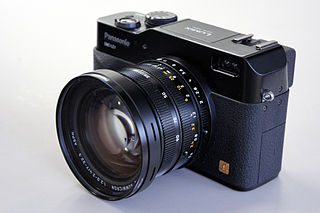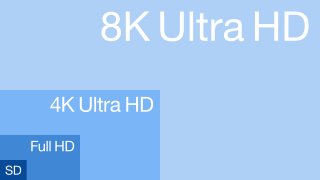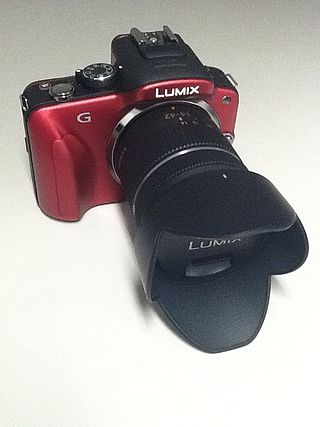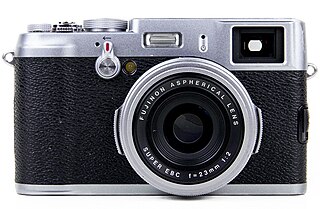Models and variants

The URSA is available in four different models: EF, PL, HDMI and Broadcast. The EF and PL mounts are interchangeable and can work with any compatible lenses. However, the HDMI model doesn't have a lens system at all and a separate camera must be connected to the camera via HDMI to record. It has a threaded camera mount to mount a camera onto the URSA. [11] The Broadcast model uses an optimized sensor for broadcasting in Ultra HD, as well as a specialized B4 lens mount and a neutral-density filter wheel on the body. [12]
URSA Mini
The Blackmagic URSA Mini is a variant of the URSA camera. The 4.6k variant was released on March 17, 2016. [8] It has a smaller form factor and loses some functionality and features over the URSA, losing the secondary 5" touchscreen, global shutter on the 4.6k variant and other features. However, it does ship in 4K and 4.6K specifications, and ships in EF and PL mounts.
URSA Mini Pro
The Blackmagic URSA Mini Pro was released on March 2, 2017. [13] Compared to the URSA Mini, it adds an internal neutral density wheel, shoulder-accessible controls, and a secondary 4" touchscreen, 2 SD and 2 C.Fast slots, auto handy focus with autofocus lenses, High Frame Rate record, HFR Mode, Timelapse recording, Video Broadcast record and ships only in a 4.6K specification. Its most unique feature is a user-interchangeable lens mount. The camera ships with an EF mount, and at release time, PL and B4 mount modules were available for purchase.
URSA Broadcast
The Blackmagic URSA Broadcast was released on February 1, 2018. [14] While not an URSA "Mini", the Broadcast uses the same platform as the URSA Mini Pro. The camera features a 4K sensor, 2/3" style B4 lens mount, traditional external controls (like on the Mini Pro), built in optical ND filters, and dual CFast and dual SD card recorders. While the Broadcast ships with a B4 mount, the camera is compatible with EF, PL and F mounts, sold separately by Blackmagic. The actual sensor size is about 13.056mm x 7.344mm, so closer to a 1" sensor, than a 2/3" sensor.
URSA Broadcast G2
The Blackmagic URSA Broadcast G2 was released on November 12, 2021. [15] It is the second generation of the URSA Broadcast line of cameras, and features a 6K Super 35 sensor. The camera had been in development for some time, but was prioritized due to difficulty sourcing the sensors used in the previous generation. [16] Though equipped with a 6K sensor, the camera can only shoot 4K when used with the B4 mount and B4 broadcast lenses, though it can film in 6K when using other lens mounts such as PL, EF or F. [17] An EF mount is provided with the camera.
URSA Mini Pro 4.6K G2
The Blackmagic URSA Mini Pro 4.6K G2, the second generation of the URSA camera, was announced in March 2019. [18] URSA Mini Pro 4.6K G2, is a professional digital film camera that combines 4.6K resolution with the traditional features and controls broadcast camera. The second generation URSA Mini Pro features fully redesigned internal electronics and a Super 35mm 4.6K HDR image sensor for much higher frame rate shooting. The camera also features built-in neutral density filters, an interchangeable lens mount, Blackmagic RAW support, and both dual CFast and SD UHS‑II card recorders. It can record video up to 300 frames per second. The Pro version also has a USB‑C expansion port that allows users to record directly to flash drives or SSD disks.
URSA Mini Pro 12K
The Blackmagic URSA Mini Pro 12K was released on July 16, 2020. [19] [20] The URSA Mini Pro 12K is the most recent addition to their URSA Mini line of cameras and boasts the highest resolution sensor of any digital film camera to date. The camera features a custom sensor, and does not use a Bayer pattern, opting instead for a sensor that includes white filters as well as the standard red, green, and blue. The camera only records in Blackmagic Raw. The camera is capable of recording 12K at 60 fps in 17:9, 4K, 6K and 8K at 120 fps, and at 4K at 240 fps, though high frame rate 4K and 6K are recorded in cropped Super 16. [21] [22] The camera ships with a PL mount, though others are available for purchase. The camera also has an inbuilt ND filters, and has a claimed dynamic range of 14 stops. [21]
URSA Mini Pro 12K OLPF
The Blackmagic URSA Mini Pro 12K OLPF was released on April 16, 2023. [23] This model is identical to the original 12K model with the addition of an Optical Low Pass Filter in front of the sensor. Unlike the older model, the OLPF version was added to the list of Netflix Approved cameras. [24]
URSA CINE 12K
The Blackmagic URSA Cine 12K was announced on April 12, 2024, and is the first URSA camera to have a full frame large format sensor. The camera has a sensor claimed to be capable of 16 stops of dynamic range, and like the previous URSA Mini Pro 12k models, has a custom RGBW sensor layout, as opposed to the more standard Bayer pattern. The camera has interchangeable PL, EF and LPL lens mount, multiple built in monitors, and built in ND filters. It is capable of recording up to 80 fps in 12K, 144 fps at 8K and 240 fps at 4K. It is Blackmagic's first camera to come with the new B-Mount battery plate as standard, though V-mount and Gold mount are available. The camera uses a new 8 TB Media Module as its default storage media, though a CFexpress adapter will become available. [25]
URSA CINE 17K
The Blackmagic URSA Cine 17K was also announced on April 12, 2024. It shares the same body as the URSA CINE 12K, with the major difference being its 17K 65mm digital sensor, and has interchangeable LPL and Hasselblad lens mounts.MobiWeb [26]














